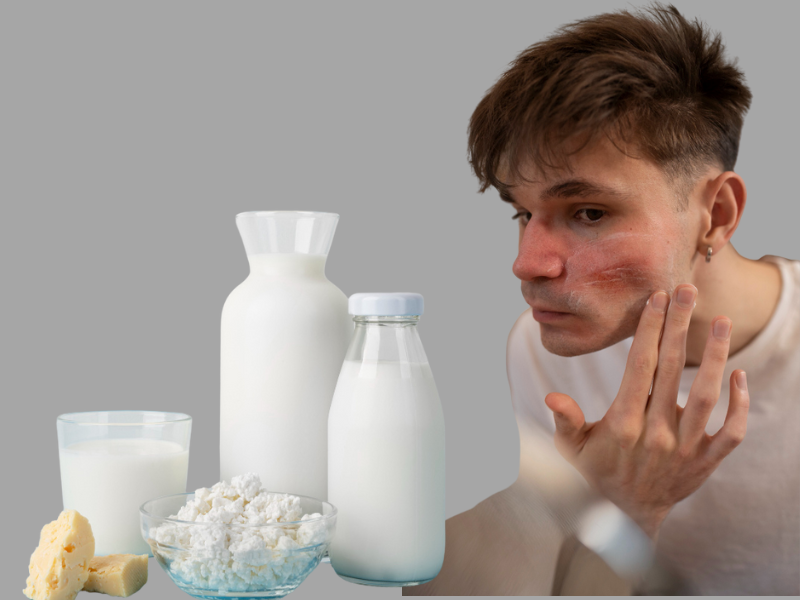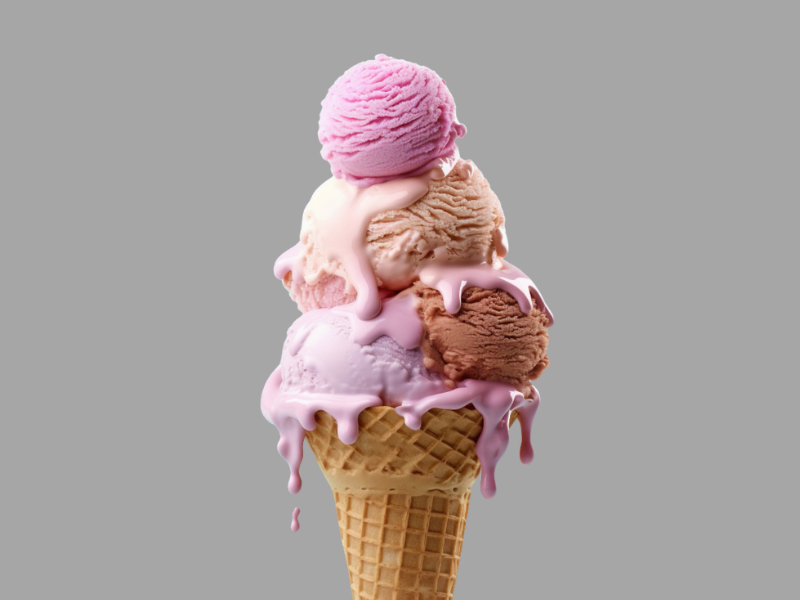Does Dairy Cause Acne?
Published: 23 Mar 2025
Have you ever wondered why your skin breaks out even following a good skincare routine? Some people blame dairy, but is it really the culprit behind acne, or is it just another skincare myth? With so much conflicting information, knowing what to believe is tough.
By the end of this article, you’ll have a clear answer on whether dairy is a hidden trigger for your breakouts. Let’s break down the facts and uncover whether dairy plays a role in causing pimples.
1- Hidden Ingredients in Dairy That May Cause Acne
Dairy contains several components that may contribute to acne by increasing oil production, inflammation, or insulin levels. Here are some key culprits:

1.1 Hormones (IGF-1 and Androgens)
- Dairy naturally contains insulin-like growth factor-1 (IGF-1) and androgens (male hormones like testosterone).
- IGF-1 is known to stimulate excess oil (sebum) production, which can lead to clogged pores and acne.
- Androgens can increase inflammation and trigger breakouts, especially in those with hormone-sensitive skin. (1)
1.2 Casein and Whey Protein
- Casein and whey are the two main proteins in milk.
- Whey protein (found in many protein powders) spikes insulin levels, which can increase IGF-1 production and worsen acne.
- Casein protein may also contribute to gut inflammation, which has been linked to skin issues. (2)
1.3 Sugar in Dairy (Lactose & Added Sugars)
- Milk contains lactose (natural milk sugar), which can cause blood sugar spikes, leading to increased insulin and IGF-1.
- Flavoured dairy products (like ice cream, yogurt, and sweetened milk drinks) often contain added sugars, further increasing acne risk.
1.4 Artificial Additives & Preservatives
- Many processed dairy products (like flavoured yogurts, ice creams, and cheese spreads) contain artificial hormones, emulsifiers, and preservatives, which may trigger inflammation and skin reactions.
Keep reading to uncover which dairy products are causing acne
2- Is Skim Milk Worse for Acne Than Whole Milk?
Many people believe that dairy causes inflammation, but is this true?

- Skim milk has been linked to increased inflammation, possibly due to processing methods that alter its protein and hormone content.
- Research suggests that skim milk may be more acne-triggering than whole milk. This is because skim milk has a higher glycemic index (a measure of how quickly food raises blood sugar levels) and contains hormones like insulin-like growth factor 1 (IGF-1), which may increase oil production in the skin. (3)
- Additionally, some individuals have dairy sensitivities or mild allergies that can trigger an immune reaction, leading to redness, swelling, or acne flare-ups.
Stay with me, next, we’ll dive into the worst offenders hiding in your fridge.
3- Do Cheese, Ice Cream, and Other Dairy Really Cause Breakouts?
Some, like cheese, ice cream, and baked goods, might be more problematic than others due to their unique composition.
3.1 Cheese and Pimples: What’s the Link?
Cheese is different from milk because it contains less lactose (milk sugar) and more fat.

- Lactose might contribute to acne in some individuals.
- High saturated fat content in cheese could also play a role in increasing oil production and inflammation.
- However, aged cheeses, which have lower lactose, may have a lesser impact on breakouts.
3.2 Is Goat Cheese a Better Choice for Acne-Prone Skin?
Goat cheese is often considered a better alternative to cow’s milk cheese because:
- Goat cheese contains less lactose than cow’s milk cheese, making it easier to digest, especially for those with lactose intolerance (which can sometimes trigger inflammation and acne). (4)
- Unlike regular cow’s milk, which mostly contains A1 casein (a type of milk protein), goat cheese has A2 casein—a form that may cause less gut inflammation and a lower immune response, reducing the chances of breakouts.
While some find goat cheese-less inflammatory, those with dairy sensitivity may still experience breakouts.
3.3 How Ice Cream Might Worsen Your Breakouts

Ice cream is a double acne trigger because it combines dairy and sugar—both of which can spike insulin levels and increase oil production.
High sugar intake can lead to glycation (a process where sugar weakens the collagen of the skin), contributing to skin inflammation and breakouts.
Not everyone experiences breakouts from dairy, but for some, cutting it out can make a noticeable difference. Here’s who might benefit from avoiding dairy:
✅ People with Frequent Breakouts or Inflammation
✅ Those with Dairy Sensitivities or Allergies
✅ Anyone Who Notices Acne Flares After Eating Dairy
Still wondering if your favourite foods are messing with your skin? Dive deeper with our latest skin-friendly diet tips, your future clear skin will thank you!
5- Conclusion
So guys, in this article, we’ve covered the question Does Dairy Cause Acne? in detail. While research suggests dairy may trigger breakouts in some people, it doesn’t affect everyone the same way.
If you’ve been struggling with acne, I recommend cutting out dairy for a few weeks and seeing how your skin responds. Your diet plays a huge role in skin health, so pay attention to what works for you!
Found this helpful? Share it with your friends
6- FAQs
For some people, yes! Dairy can trigger acne due to its hormones and inflammatory effects, but not everyone is sensitive to it. The best way to know is to eliminate dairy for a few weeks and observe your skin.
It depends on your skin, but most people notice changes within 2 to 6 weeks. Acne caused by dairy-related inflammation takes time to heal. Be patient and track your progress to see if your breakouts improve.
Greek yogurt has less lactose than regular milk, which may make it a better option. However, it still contains casein and whey proteins, which can trigger acne in sensitive individuals. If you’re cutting out dairy for acne, it’s best to avoid all forms, including yoghurt.
Cookies contain dairy, sugar, and refined flour, all of which can contribute to breakouts. Sugar spikes insulin levels, which can increase oil production and inflammation. If you notice breakouts after eating sweets, try reducing them and see if your skin improves.
Pancakes often contain milk, eggs, and sugar, which can increase oil production and inflammation. If they’re made with processed flour and topped with sugary syrups, the risk of breakouts increases. Healthier alternatives include whole-grain or dairy-free pancakes
Milk contains hormones (like IGF-1) and dairy proteins that may trigger oil production and clogged pores. For some, this leads to acne, while others don’t experience any effects. If your skin is prone to breakouts, cutting back on dairy might help.
Colostrum (the first milk produced after birth) is rich in growth factors that may stimulate oil production. Some studies suggest it might worsen acne in sensitive individuals, while others believe it supports skin healing. If you’re acne-prone, be cautious and monitor how your skin reacts.
No, some people can consume dairy without any issues, while others experience breakouts, redness, or irritation. Genetics, gut health, and hormone levels all play a role. The best way to know is to experiment with your diet and see how your skin reacts.
Good alternatives include almond milk, coconut milk, oat milk, and cashew milk, as they don’t contain acne-triggering dairy proteins. Avoid soy milk if you’re sensitive to hormones, as it can also affect the skin. Always check for added sugars, which can also contribute to breakouts.
Yes! Many people find that removing dairy reduces breakouts, redness, and inflammation, making their skin look clearer and more radiant. Pairing a dairy-free diet with hydration, antioxidants, and a balanced diet can further improve skin health.
7- References
At MedicaWire, all medically sensitive content is reviewed by licensed healthcare professionals. Our team ensures that the information you read is accurate, up-to-date, and based on trusted medical sources.
Learn how we maintain high standards by reading our Editorial Policy.
📚 Sources
- Aghasi M, et al. (2019). Dairy intake and acne development: A meta-analysis of observational studies.
https://pubmed.ncbi.nlm.nih.gov/29778512/ - Juhl CR, et al. (2018). Dairy consumption and acne: A systematic review and meta-analysis of 78,529 children, adolescents, and young adults.
https://pubmed.ncbi.nlm.nih.gov/35373155/ - Kumari R, Thappa DM. Role of insulin resistance and diet in acne.
- https://pubmed.ncbi.nlm.nih.gov/23619434/Smith RN, et al. (2007). A low-glycemic-load diet improves symptoms in acne vulgaris patients: A randomized controlled trial.
- https://pubmed.ncbi.nlm.nih.gov/17616769/
ℹ️ Our Promise
MedicaWire follows strict sourcing guidelines and only references peer-reviewed studies, academic institutions, and reputable medical associations. We update content regularly to reflect new health information.

- Be Respectful
- Stay Relevant
- Stay Positive
- True Feedback
- Encourage Discussion
- Avoid Spamming
- No Fake News
- Don't Copy-Paste
- No Personal Attacks



- Be Respectful
- Stay Relevant
- Stay Positive
- True Feedback
- Encourage Discussion
- Avoid Spamming
- No Fake News
- Don't Copy-Paste
- No Personal Attacks





